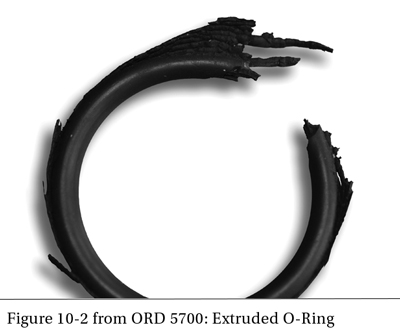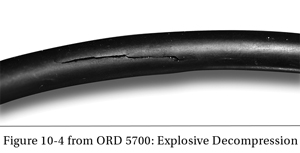Article re-posted with permission from Parker Hannifin Sealing & Shielding Team.
Original content can be found on Parker’s Blog.
In the Oil & Gas industry, the need for elastomers to seal higher pressures for sustained periods of time with minimal damage is abounding. Applications such as drilling tools, completions equipment, blow out preventers, and subsea pressure control systems now routinely require or exceed 15,000 psi with both liquid and gas media for functional testing and qualification. Parker meets this challenge, providing a best-in-class extrusion and rapid gas decompression resistant hydrogenated nitrile (HNBR) compound called KB292.
One of the most common failure modes for seals utilized in high pressure applications is known as extrusion or nibbling. This failure method emerges when the seal material is forced into a clearance gap that is present between the mating substrates and gradually can be cut, nicked, or chewed away. Typical applications which can see this transpire include dynamic reciprocating cylinders and/or vessels where pressure fluctuations cause clearance gap to open and close trapping the seal between mating surfaces. The higher the pressure or the larger the clearance gap that is present, the more likely extrusion or nibbling is to occur. Once a mass of the material is removed from the seal geometry it is inevitable that a leak will eventually form which normally results in failure of the system. Section 10 of the Parker O-Ring Handbook highlights extrusion and nibbling as well as includes several suggestions for prevention.
Another failure mode which can be seen for high pressure gaseous applications is known as Rapid Gas Decompression (RGD), also referred to as Explosive Decompression (ED). This damage arises after a period of service under high pressure gas, when pressure is reduced too rapidly, the gas trapped within the internal structure of the seal expands rapidly, causing small ruptures or fissures to develop. There are many Oil and Gas industry standard tests which have been developed to determine whether compounds are RGD resistant. Parker routinely tests and acquires certificates for these standards which can be supplied upon request for end user documentation. Parker's Oil & Gas Reference Guide outlines numerous materials, temperature ranges, recommended uses, and a list of approved certifications by material.
New Technology - HNBR KB292
To combat seal damage and the typical failures in high pressure applications, Parker has developed material KB292. This hydrogenated nitrile (HNBR) based material has been formulated with physical properties which allow it to withstand exposure to the highest-pressure environments with extreme extrusion resistance. With hardness of 95 +/- 5 Shore A points, KB292 is one of the hardest elastomers in the Parker OES material offering. The extreme extrusion resistance is also identified with a modulus value of 2500psi at 50% elongation as well as excellent abrasion and tear resistance. The material offers good compression set and chemical resistance that is expected from all Parker HNBR’s used in the O&G industry. Additionally, Parker's KB292 has been tested to and passes the requirements of ISO 23936-2 RGD which shows excellent resistance to explosive decompression for high pressure gas applications.
For more information about the KB292 compound, reference Parker’s OES 7003 technical bulletin.
Gallagher Fluid Seals is an authorized Parker distributor.
For more information about Parker's compounds or sealing applications, contact Gallagher Fluid Seals today.


